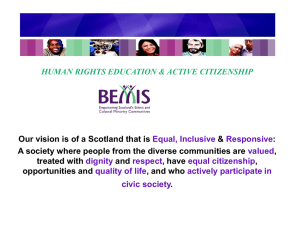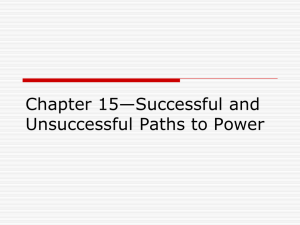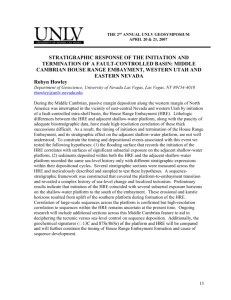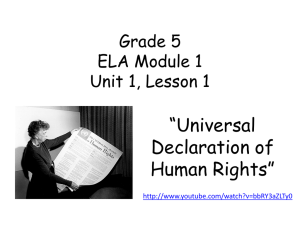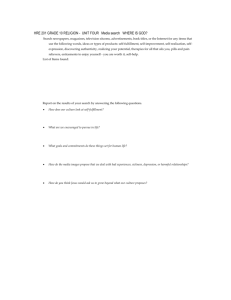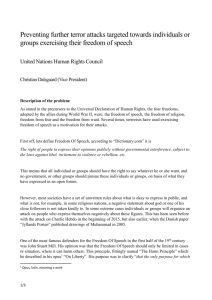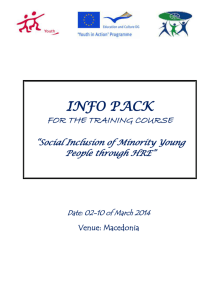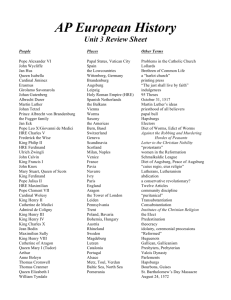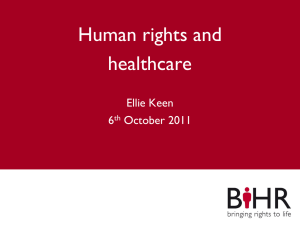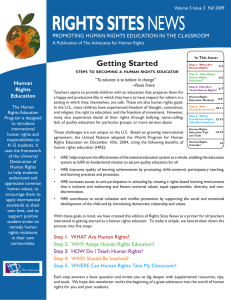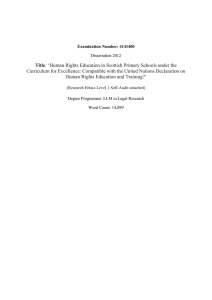Building a Human Rights Learning Community
advertisement
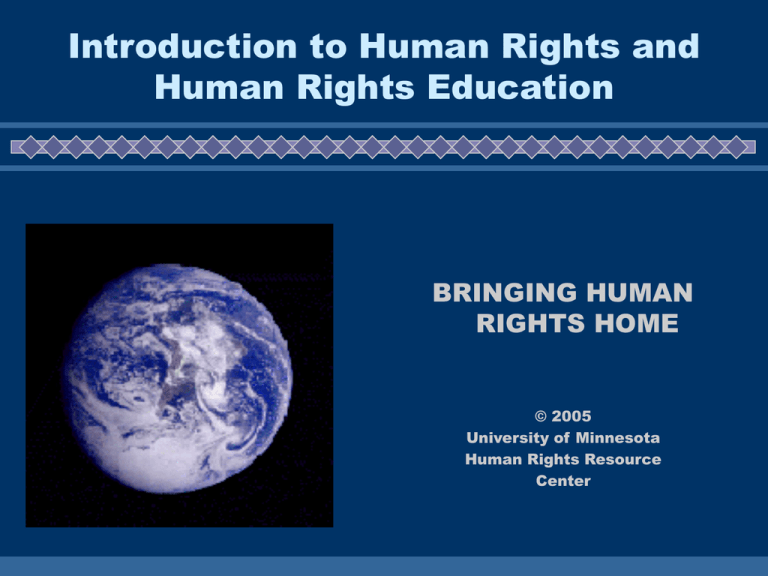
Introduction to Human Rights and Human Rights Education BRINGING HUMAN RIGHTS HOME © 2005 University of Minnesota Human Rights Resource Center FRAMING OUR HUMAN RIGHTS QUESTIONS What are the historic and philosophical foundations for “human rights”? What are the underlying principles of the Universal Declaration of Human Rights? How does the Universal Declaration of Human Rights and our stories connect to Human Rights Education? How do we tell our story of the evolution of human rights and human rights education? OUR PAST STORIES We must recognize our ancestors and elders, whose shoulders we are standing upon! Philosophical Visions: Human Nature - A search for Common secular inquiry and human reason 400 B.C.E. est. - Mo Zi founded Mohist School of Moral Philosophy in China Importance of duty, self-sacrifice, and an all-embracing respect for others – “universally throughout the world” 300 B.C.E. est. – Chinese sage Mencious Wrote on the “human nature” – “humans are fundamentally good, but goodness needs to be nurtured” 300 B.C.E. est. – Hsun-tzu Asserted “to relieve anxiety and eradicate strife, nothing is a effective as the institution of corporate life based on a clear recognition of individual rights” Philosophical Visions: Human Nature 1750 B.C.E. – King Hammurabi in Babylon Necessary to honor broad codes of justice among people. Created one of the earliest legal codes to govern behavior – “let the oppressed man come under my statue” to seek equal justice in law Ancient Egypt Explicit social justice – “comfort the afflicted…refrain from unjust punishment. Kill not…make no distinction between the son of a man of importance and one of humble origin” Early Sanskrit writings in Indian Responsibility of rulers for the welfare of people. “Noone should be allowed to suffer… either because of poverty or of any deliberate actions on the part of others” Philosophical Visions: Human Nature with Spiritual/Religious Traditions 300 B.C.E. – Ashoka of India Freedom of worship and other rights of his subjects. Other leaders from this area impartial justice and social equality and no castes should exist since all are from one tree 16th century - Hindu philosopher Chaitanya “There is only one caste – humanity” Sikh leader Guru Gobind Singh Proclaimed “recognize all the human race as one” 10th Century - Al-Farabi, an Islamic Philosopher Wrote The Outlook of the People of the City of Virtue, a vision of moral society in which all individual were endowed with rights and lived in love and charity with their neighbors. Philosophical Visions: Natural Law – focused on universal responsibilities and duties rather than what are now described as rights Greek Philosophers Equal respect for all citizens (insotimia). Equality before the law (isonomia). Equality in political power (isokratia) and Suffrage (isopsephia). Marcus Tillius Cicero “Universal justice and law guided human nature to act justly and be of service to others” – This natural law “binds all human society” together, applies to every member of “the whole human race” without distinction and unique dignity of each person. French philosopher Jean-Jacques Rousseau (1762) “Man is born free, but everywhere he is in chains” Precursors to 20th Century Human Rights Documents 1750 B.C.E. – Code of Hammurabi, Babylonia 1200 - 300 B.C.E. – Old Testament 551 - 479 B.C.E. – Analects of Confucius 40 - 100 C.E. – New Testament 644 - 656 C.E. – Koran 1215 – Magna Carta, England 1400 – Code of Nezahualcoyotl, Aztec 1648 – Treaty of Westphalia, Europe 1689 – English Bill of Rights, England 1776 – Declaration of Independence, United States 1787 – United States Constitution 1789 – French Declaration on the Rights of Man and the Citizen, France 1791 -United States Bill of Rights 19th and 20th Century Human Rights based on Natural Rights 1863: Emancipation Proclamation, United States 1864 & 1949: Geneva Conventions, International 1919: 1920: 1926: 1945: 1947: Red Cross League of Nations Covenant, International Labor Organization (ILO) Created Women gain the right to vote in the U.S. Slavery Convention United Nations Charter, San Francisco Mohandas Gandhi uses non-violent protests leading India to independence. Philosophical Visions: Human Rights & the Social Construction of Human Nature A Moral Vision of Human Nature Human Rights set the limits and requirements of social (especially state) action. But the state and society, guided by human rights, play a major role in realizing that “nature.” When human rights claims bring legal and political practice into lines with their demands, they create a person in line with a moral vision. (Donnelly, 2003) “Human Rights Theories and documents point beyond actual conditions of existence to what is possible.” “Treat a person like a human being and you’ll get a human being.” What are the Human Rights Principles? The rights that someone has simply because he or she is a human being & born into this world. Core Principles: Human Dignity Equality Non-discrimination Universality Interdependency Indivisibility Inalienability Responsibilities What are the Common Myths about Human Rights in U.S.? Human Rights = civil rights. Economic, Social, and Cultural Rights (i.e., healthcare, housing) are privileges. Human Rights applies only in poor, foreign countries. Human Rights are only concerned with violations. Only lawyers can understand the significance of Human Rights. Five Primary Categories of Human Rights: Civil Rights Political Rights Economic Rights Social Rights Cultural Rights Universal of Declaration of Human Rights History and Current Status The Universal Declaration of Human Rights (UDHR) was drafted by the UN Commission on Human Rights chaired by, then first lady, Eleanor Roosevelt. The UDHR was adopted by the 56 member nations of the UN General Assembly on December 10, 1948. December 10th is celebrated around the world as International Human Rights Day. The 192 member states in the U.N., upon membership, agreed to educate their citizens about the principles of the UDHR. Most of these countries have incorporated the principles of the UDHR into their constitutions. “The UDHR specifies minimal conditions of a dignified life.” Human Rights USA 1997 Survey Results Only 8% of adults and 4% of young people are aware the Universal Declaration of Human Rights exists. After learning about the UDHR, a large majority, 83%, feel that the US should do more to live up to the principles of the UDHR. 2/3 of the people polled (63%) say that the poor are usually discriminated against in US. Others discriminated against: the disabled (61%), the elderly (54%), gays and lesbians (51%), Native Americans (50%), and African Americans (41%). International Bill of Human Rights Universal Declaration of Human Rights (UDHR) December 10, 1948 Int'l Covenant on Civil and Political Rights Int'l Covenant on Economic, Social and Cultural Rights (ICCPR) Adopted by UN General Assembly in 1966 Entered into Force in1976 (ICESC) Adopted by the UN General Assembly in 1966 Entered into Force in1976 2 Optional Protocols to the ICCPR (Member nations permit individuals or groups to report personal human rights violations to the UN Human Rights Committee) Selected Human Rights Conventions/Treaties International Convention on the Elimination of all forms of Racial Discrimination, 1966 Convention on the Elimination of all Forms of Discrimination against Women, 1979 Convention on the Rights of the Child, 1989 How do we move from learning about Human Rights to promoting and protecting them on a personal and community level? OUR PRESENT STORIES We must share, listen, and respect each other’s stories and journeys, working for human rights and human rights education! Personal and Community Human Rights Learning Wheel KRP - 1999 Inspire Know Value Celebrate Reflect Act Connect Heal Building Blocks for Human Rights Education BLOCK 1 – THINKING Know your human rights BLOCK 2 – FEELING Value your human rights BLOCK 3 - EQUIPPING Learn new human rights Skills BLOCK 4 – ACTING Practice human rights Measuring the Impact and Being Accountable STEP 1 – MEASURING IMPACT What are initial outcomes? STEP 2 – REFLECTING Was our intent the impact? STEP 3 – COMMUNICATE OUR LEARNING & JOURNEYS Can we connect and hold each other accountable? STEP 4 – CELEBRATE OUR EMERGING PRACTICES Can our work be a means rather than an end? Who are the Stakeholders and Responsible Partners in our Human Rights Community? Governor Mayor and City Council Elected Officials and Dept of Human Rights Ombudsman & HR League School Suprintendent /Commissions Principals and University Deans Teachers, Faculty, and Staff /President Students Parents Police & Law Enforcement NGOs /Non-Profit Organizations Philanthropic Donors and Funders Libraries, Hospitals, and Parks Largest Private Employers How will we gauge the Progress in Realizing our Human Rights Community? Annual HR Statical Report Card Community Testimonies Public Education and Events Public Accommodations Graduation Rates Income Comparisons Hiring Trends in Public and Private Sectors Recruitment of People of Color in Educational Institutions Arrests and Conviction Rates & Legal Assistance Homeownership Rates What is Human Rights Education? 1993 Vienna Declaration and Programme of Action, Part 1, para. 33 “The World Conference on Human Rights reaffirms that States are duty-bound…to ensure that education is aimed at strengthening the respect of human rights and fundamental freedoms [and that] this should be integrated in the educational policies at the national as well as international levels.” The UN resolution declaring the Decade for Human Rights Education, 1995-2004 Human rights education should involve more than the provisions of education and should constitute a comprehensive life-long process by which people at all levels in development and in all strata of society learn respect for the dignity of others and the means and methods of ensuring that respect in all societies. The World Programme for Human Rights Education (A/59/525/Rev. 1) Human rights education can be defined as education, training and information aiming at building a universal culture of human rights through the sharing of knowledge, imparting of skills and moulding of attitudes directed to: (a) The strengthening of respect for human rights and fundamental freedoms; (b) The full development of the human personality and the sense of its dignity; (c) The promotion of understanding, tolerance, gender equality and friendship among all nations, indigenous peoples and racial, national, ethnic, religious and linguistic groups; (d) The enabling of all persons to participate effectively in a free and democratic society governed by the rule of law; (e) The building and maintenance of peace; (f) The promotion of people-centered sustainable development and social justice. The World Programme for Human Rights Education Launched January 1, 2005 – December 31, 2007 • Resolution 2004/71 of the Commission on Human Rights supported the first phase (2005-2007) of the World Program for HRE to focus on primary and secondary school systems. • UN General Assembly adopted resolution in support of The World Programme for HRE (12/10/05) • Revised draft plan of action for the first phase (20052007) of the World Programme for HRE What is the Human Right to Education? Everyone has the human right to education, training and information Education should be directed to the full development of the human personality and the strengthening of human rights and fundamental freedoms. Governments’ Obligations to Ensuring the Human Right to Education “Everyone has the right to education….Education shall be directed to the full development of the human personality and to the strengthening of respect for human rights and fundamental freedoms.” UDHR, Article 26 “State parties undertake to prohibit and to eliminate racial discrimination…and to guarantee the right of everyone without distinction as to race, colour, or national or ethnic origin…in the enjoyment of…the right to education and training.” CERD, Article 5 ICESCR (Art. 13), CRC (Art. 29), & CEDAW (Art. 10). In response to new World Programme on HRE, Governments need to develop plans for HRE in primary and secondary school education. HUMAN RIGHTS EDUCATION for PEACE BUILDING: A Planning & Evaluation Handbook Recommendations to International and National Actors Based on research in El Salvador, Guatemala, Liberia, Mexico and Sierra Leone Paul Martin,Tania Bernath, Tracey Holland Loren Miller DRAFT 10/28/2002 “Human Rights Education is a means towards social change; a tool to transform the theory and practical applications into everyday social practice.” “In conflict situations and in peace building, HRE must be seen to benefit the target populations’ daily lives.” Paul Martin et al “HRE focuses especially on social goals and ideals that emphasize the dignity of all human beings and the need for laws and institutions that enforce those standards. In so doing, HRE contributes directly to the process of building a society based on freedom, peace and Justice.” Paul Martin, et al. CORE COMPONENTS OF HUMAN RIGHTS EDUCATION PROGRAMS (1) You have rights and members of government are obliged to protect and promote them; and (2) You can gain the knowledge and skills to use to protect and implement those rights in real life and subsequently improve your and community-wide living conditions. Paul Martin,Tania Bernath, Tracey Holland Loren Miller (Draft 2002) HRE PROGRAM I. WHY? Goal Setting Questions (1) What do we hope to achieve through HRE? (2) How will the promotion of human rights contribute to goal(s)? (3) In the absence of an effective local government, how can common rules based on international standards become part of national law and be enforced to ensure respect for these rights for both nationals and expatriates alike? I. WHAT Content & Skills? Questions to Determine Content/Skills (1) What are the participants greatest concerns and how do they relate to human rights? (2) What human rights concerns have the participants identified? (3) What articles from which international documents in human rights and humanitarian law reflect the concerns of this population at this time? (4) How are human rights principles reflected in the activities of state and local Institutions? (5) What skills do we need to gain to redress these concerns? III. HOW TO CHOOSE PROCESS & METHODS? Questions About Implementation (1) How can we engage the participants in the learning process? (2) What approaches will make these topics come alive for the participants? (3) How should one organize and structure the goals and topics to be taught? (4) What do participants learn from the way that we facilitate process? (5) How can we use the classroom dynamic to reinforce our goals and topics? (6) What methods will best help participants learn and apply this knowledge? IV. WHO are actors in teaching/training and learning? Questions for Determining Actors (1) What arenas of society should be the focus for human rights education? (2) What experience, talents, and skills will best serve the educational and human rights goals? (3) How can local and international efforts best be combined in the application of human rights education? (4) What kinds of experts are needed to implement human rights education? Paul Martin,Tania Bernath, Tracey Holland, and Loren Miller (Draft 2002) What are some models and effective practices in HRE Programs in the U.S. and the Americas? National Human Rights Resource Center http://www.hrusa.org Passports on Universal Declaration of HR and Convention on the Rights of Child (@ 1/2 million distributed) Human Rights Here & Now Curriculum (@25,000 distributed) “Taking Your Human Rights Temperature of Your School” (adapted/translated into numerous other languages) Human Rights and Peace Bookstore National Training of Trainers HRE Institutes National Human Rights Resource Center – U of MN Beyond September 11 Curriculum – http://www.beyondseptember11.org Human Rights Education Handbook: Effective Practice for Learning, Action & Change http://www.hrusa.org “Dismantling Racism and Human Rights” Workshops for Trainers Partnering on Training for the Police, FBI, Judiciary, and New Immigrants Police and Civilian Review Board Human Rights Library – http://www.umn.edu/humanrts Largest Primary human rights documents Web site available in 6 languages: Spanish, English, French, Russian, Arabic, Japanese. Chinese is coming soon. @ 120,000 hits in one month period. @ 3,500 Human Rights Links. Link to the Resource Center for fulltext training resources free on-line. New UN Guidelines on Transnational Corporations & HR now available. This is My Home: A Minnesota HRE Experience - 2005 Primary and Secondary School HRE initiative (1)To create learning environments for all students to develop to full potential (2)To motivate all members of school community to take responsibilities for HRE (3)To share effective practices on Web site Minnesota Global, Human Rights, and Peace Education Network (1) CENTER FOR VICTIMS OF TORTURE. Works with teachers to help them understand unique needs of students and families coming from War-torn countries. (www.cvt.org) (2) MN ADVOCATES FOR HUMAN RIGHTS. Has implemented a full “Rights Sites” approach with 8 schools and also developed a “Building Immigrant Awareness & Support” curriculum and video. (www.mnadvocates.org) (3) MN INTERNATIONAL CENTER. Brings immigrants and refugees into classrooms to speak about their countries. (www.mic.org) Minnesota Global, Human Rights, and Peace Education Network (4) RESOURCE CENTER FOR THE AMERICAS. Conducts teacher training, hosts a bi-lingual curriculum bookstore, and runs a youth-lead Child Labor Project. (www.americas.org) (5) U of MN HUMAN RIGHTS RESOURCE CENTER. Works with St. Paul School District on “Respect and Human Rights Campaign” Coaching and Curriculum Integration (www.hrusa.org) (6) WORLD CITIZENS. Works with schools to become peace sites and integrate human rights and peace curriculum. Measuring Human Rights Community “Temperature” Moorhead Residence Survey on Discrimination, Moorhead Chamber of Commerce, 1998 Housing 58% Health care 19% Neighborhood 53% Police 48% Churches 11% Shopping 28% City Govt. 24% Employment 31% Martin Luther King, Jr., Last Speech on April 3,1968 “Men, for years now, have been talking about war and peace. But now, no longer can they just talk about it. It is no longer a choice between violence or non-violence in this world; it’s nonviolence or nonexistence. That is where we are today. And also in the human rights revolution, if something isn’t done, and in a hurry, to bring the colored peoples of the world out of their long years of poverty, their long years of hurt and neglect, the whole world is doomed.” The U of MN Human Rights Center N-120 Mondale Hall, U of MN Law School 612-626-0041 Primary Human Rights Documents www.umn.edu/humanrts Human Rights Education and Training www.hrusa.org Human Rights and Peace Store www.humanrightsandpeacestore.org Eleanor Roosevelt, 1958 “Where, after all do universal rights begin? In small places, close to home – so close and so small that they cannot be seen on any maps of the world. Yet they are the world of the individual person; the neighborhood he lives in; the school or college he attends; the factory, farm or office where he works. Such are the places where every man, woman, and child seeks equal justice, equal opportunity, equal dignity without discrimination. Unless these rights have meaning there, they have little meaning anywhere. Without concerted citizen action to uphold them close to home, we shall look in vain for progress in the larger world.”
